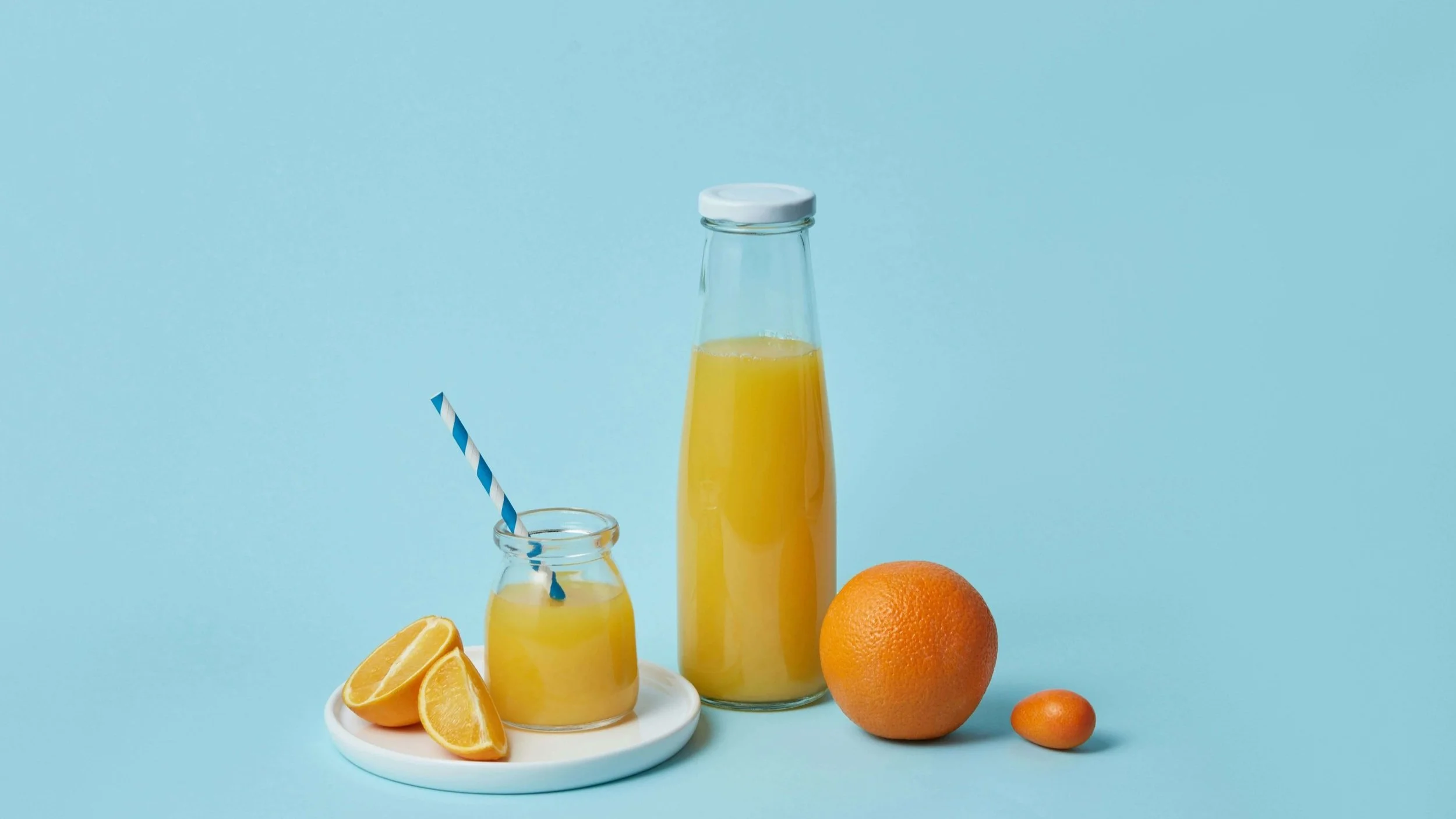100% juice nutrition: new science vs old nutrition stories
Food and nutrition science is ever evolving. So what happens when new research challenges ingrained nutrition stories?
We explore 4 key takeaways from the reaction to our 100% juice study, and how the food and nutrition profession can work together to evolve with the science.
Image: Juice nutrition is in the spotlight (Credit: Pexels).
Last year FOODiQ Global authored a high-quality review of the existing scientific evidence on the health effects of drinking 100% juice.
Like all our research, we went in with an open mind and genuine curiosity in what the existing evidence would tell us.
So, what did the existing evidence on 100% juice show? Our umbrella review found that:
There is moderate quality evidence that drinking 100% juice improves several markers of cardiovascular health, including clinically meaningful reductions in systolic and diastolic blood pressure, uric acid, and an increase in flow-mediated dilation.
There is moderate quality evidence that drinking 100% juice lowers C-reactive protein, a marker of inflammation.
While more studies are needed, the current available evidence, which was of very low quality, shows that consumption of 100% juice does not lead to weight gain.
In observational studies, there was very low-quality evidence that 100% juice was associated with increased risk of type 2 diabetes, prostate cancer, CVD mortality, and reduced risk of stroke mortality.
Taking into account the totality and strength of the evidence, the balance of evidence as a whole suggested that consuming 100% juice can likely have some health benefits, and has limited evidence of harm.
Our research indicated that the science had evolved, and it was time to rethink the ‘villain edit’ that juice had received in recent years.
Following the publication of the research, we shared our study via our Juice Hub, held webinars for health professionals, and communicated our findings to health stakeholders.
For the most part, the response to our research was positive. Following the webinar, 75% of participants said that the new information had changed their perspective on 100% juice, and they could now recognise the potential health benefits of including it in the diet.
Not everyone, however, was happy with our findings. Some of the concerns raised by a minority in health and nutrition circles included:
“Juice has little fibre - people should just eat the whole fruit.”
“Juice is high in free sugars – it must be limited.”
“The study was funded by ‘big juice.’”
“I still won’t recommend juice to my clients – in practice it will cause weight gain”
As experienced nutrition scientists, we are committed to the scientific process and welcome robust, constructive criticism of our work - after all, that’s how science evolves and improves. This was different. Most of the criticisms weren’t in line with the science that we shared, and many simply reiterated previous concerns about drinking juice.
Being the curious foodies that we are, we wanted to dig a bit deeper and understand the ‘why’ behind this mixed reaction. Why is it that some studies – like our juice research - elicit this type of response from the nutrition community, and how does this impact the application of evidence-based science to improve health outcomes?
In considering this question, we came up with 4 key takeaways:
1. New science can be uncomfortable for old public health nutrition stories
Image: Updated evidence ideally results in updated views; but that’s not always the case. (Credit: Pexels)
It is a difficult time for building and maintaining public trust in nutrition science. Messages regarding nutrition in mainstream and social media are often confusing, contradictory and inaccurate. Single studies are picked up and reported as fact, while extreme diets are presented as the ‘solution’ to a myriad of health issues.
In this context, it is understandable why the nutrition profession and public health authorities would like to avoid the perception of ‘backflipping’ on any established nutrition advice.
For a long time now, the story of fruit juice has been dominated by messages of excess free sugars, a lack of fibre and liquid calories leading to weight gain. Over time this story has become ingrained as dogma, in the nutrition and health space and beyond.
Our research challenged this narrative. We presented evidence that an alternative, more nuanced approach on the role of 100% juice in the diet was needed.
For some, this presented a threat to the existing public health messages, and the safer option was to reject our findings and defend the status quo. There is no grey area – juice is the villain.
The reality is that science will continue to evolve (as it should!) and people in a position to influence individual food choices who disregard new evidence risk giving outdated advice.
This is not to say that nothing in food nutrition science is agreed on, and everything is up for debate. Despite the online confusion, there is broad consensus in the nutrition space over what is a healthy eating pattern: eat more fruit and vegetables, wholegrains, nuts and seeds as well as dairy, lean meats and their alternatives.
Rather than fight emerging research, the nutrition profession may need to improve on communicating what we agree on, and get more comfortable with exploring and translating areas of nutrition that are more nuanced.
2. The nutrition field has an issue with reductionism
Image: More than just sugar - 100% juice is complex, and can’t be reduced to one or two nutrients. (Credit: Pexels).
When talking about juice nutrition, two main nutrients often come up: sugar (it contains too much) and fibre (it contains too little).
The problem with this line of reasoning is that it reduces a complex food product into just two nutrients.
The reality is far more dynamic – and interesting. There are 26,000+ components in foods that are known to have a biological effect . Modern nutrient databases track just 140 (or 0.5%) of these. This may be why some foods behave differently in the body to what we expect.
We know that 100% juice has a micronutrient profile largely comparable to whole fruit, with orange juice containing health promoting B vitamins, vitamin C, potassium and magnesium. Juice also contains bioactive compounds including polyphenols, and carotenoids in the case of yellow, red and orange juices. Combined with the micronutrients, these compounds may produce the potential health benefits borne out in the research.
This synergy between nutrients, bioactives and the human body isn’t something you can appreciate from a nutrition label. Reducing 100% juice to an excess of sugar and a lack of fibre misses the potential to explore this messier, but exciting, area of nutrition science.
While we may not have all the answers on how bioactives work to support human health, they demonstrate the importance of researching the effects of consuming whole foods and beverages, rather than just isolating single nutrients. By considering the whole food and how its individual components operate synergistically in the body, we can achieve a much more accurate picture of the health and nutrition benefits of products like 100% juice.
3. Dietary guidelines are not rules: context matters
Image: Dietary guidelines were never intended to be applied without context (Credit: Pexels).
The Australian Dietary Guidelines play a vital role in promoting patterns of eating that can help improve public health outcomes. While important, they were never intended to be applied to individuals without context and consideration of social and other determinants of health that affect food choices.
So, what do dietary guidelines say about 100% fruit juice?
The Australian Dietary Guidelines recommend eating the whole fruit over fruit juice, as it has more fibre and is less acidic. This is true, and if given the option a whole orange is generally preferred over a glass of whole orange juice. But context is critical, and ‘healthy’ looks different for different people.
In 2014-15, 50% of adults in Australia weren’t eating the recommended two serves of fruit per day. Children fared a bit better, however 32% still didn’t reach the recommended target. Despite numerous public health interventions, fruit and vegetable intake in Australia remains low.
People struggle with fruit intake for a variety of reasons: taste, convenience, cost. Like most aspects of food and nutrition, socio-economic status and geography also impact people’s ability to access and consume fresh whole fruit. Rather than just telling people to ‘eat more fruit,’ 100% juice – which is available all year round - may be used as a tool to help these populations increase their intake of health promoting nutrients and bioactives. After all, some vitamins and bioactives are better than none. And as the best available research suggests, there are potential health benefits and limited evidence of harm.
The Australian Dietary Guidelines are an important public health tool, but it’s critical that the experiences of individuals and communities are taken into account when dishing out dietary advice. Writing off foods just because a healthier option exists lacks nuance, and may prevent people accessing ‘healthy-enough’ options.
4. We need to talk more about industry funding and bias
Image: In research, there is a difference between ’risk of bias’ and ’bias’ (Credit: Pexels).
One criticism of our research is that it was funded by Hort Innovation and AUSVEG. Hort Innovation is the grower-owned, not-for-profit research and development corporation for Australia's horticulture industry, while AUSVEG is the peak industry body for the Australian vegetable industry.
This is a valid point to raise for discussion, and one that we welcome. Industry funding of research is not a new topic, but it’s one that requires ongoing vigilance and attention.
Studies looking at the role that industry funding plays on food and nutrition research outcomes have yielded mixed results. Some have found examples of funding leading to positive bias towards industry in research findings, while others have concluded that the funding source was irrelevant to the overall study quality and outcomes. This is why authors are required to declare funding arrangements and conflicts of interest as part of every academic paper submitted for publication. The reader needs to be made aware of the risk that third parties may have had influence over the research development and outcomes.
It's important however to make the distinction between ‘risk of bias’ and ‘bias.’
The former does not necessarily translate to the latter. Experienced food and nutrition researchers are well versed in mitigating and reducing the risk of undue influence in research, whether it is in the form of monetary, political or organisational pressure. This is at the very core of good scientific practice.
While Hort Innovation funded the FOODiQ 100% juice research, they were not involved in the final research question, methodology, interpretation of results or publication. With our 100% juice study – and every project we do – we go above and beyond industry funding guidelines to ensure all of our work is led by the science.
Remaining vigilant over the funding sources of research is a good thing. Dismissing any research with industry funding, however, can do more harm than good. This approach would exclude a significant body of science that could be used to benefit global human health, and may be used to reject research not on the basis of good science, but because it doesn’t fit a particular nutrition story or worldview.
Our 100% juice research was never intended to provide the definitive answers on whether juice is ‘good’ or ‘bad.’ It’s the start of a conversation, and we are excited to see what the scientific community does next in this space.
Takeaways:
New research is not always judged on its quality or evidence base – sometimes existing narratives on food and nutrition can cloud interpretation of the science.
The nutrition of a food is far greater than the sum of its parts - nutrition reductionism is on its way out.
Guidelines are guidelines, not rules.
To reduce the risk of bias in science, we need open and honest conversations about the role of industry funding in food and nutrition research.





